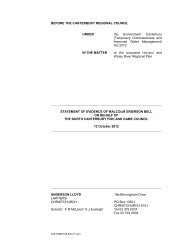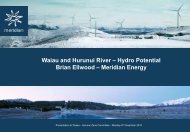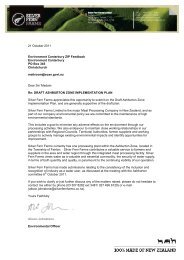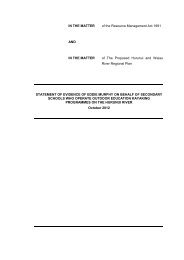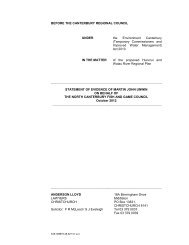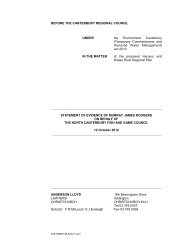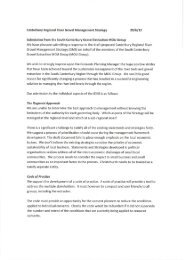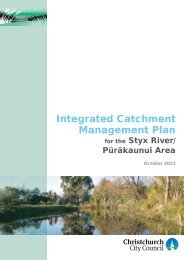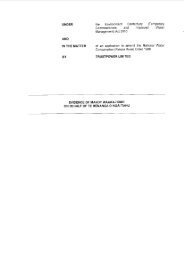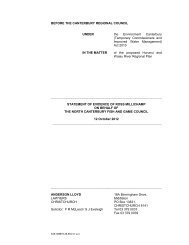Geological contours for groundwater modelling, South Canterbury
Geological contours for groundwater modelling, South Canterbury
Geological contours for groundwater modelling, South Canterbury
Create successful ePaper yourself
Turn your PDF publications into a flip-book with our unique Google optimized e-Paper software.
<strong>South</strong>west of Pareora River in the vicinity of the Craigmore tableland, there is internal conflictbetween the measured bedding attitudes and the mapped distributions of geological<strong>for</strong>mations. Several of the measured dips (QMAP digital database), of the order of 40°,cannot be representative, otherwise <strong>for</strong>mations different to those mapped would crop outfrom place to place. In fact, the stratigraphic picks indicate small-scale anticlinal/synclinalstructures within the overall anticlinal feature. This structural style lends weight to theinterpretation, adopted here, that the Brothers Fault continues southwest along thenorthwestern flank of the Craigmore tableland.Boundaries between stratigraphic sectors SS3a, b, c, and d reflect transitions to the use ofdifferent measured sections rather than distinct geological boundaries.3.2.1.4 Geraldine downs and plainsNorth of Geraldine (SS4; Fig. 33.2.1.3), an east-trending anticline is inferred largely frombedding attitudes in the Kowai Formation. This structure may well be a continuation of theRapuwai fault block at Kakahu. Geraldine Basalt has been detected in bore holes west andsouth of its known outcrop area on the Geraldine Downs (Barrell 2008). Since 2008, basalthas been intersected at two further locations, one just east of Temuka township (K38/1517)and near Mil<strong>for</strong>d Huts just northwest of the Opihi River mouth (K38/1712). The basaltencountered in these bores is inferred to be contiguous with Geraldine Basalt, and thestratigraphic thickness of Cretaceous-Cenozoic rocks from the measured section at KakahuRiver applied to estimate depth to basement. As there is no direct dip control, a uni<strong>for</strong>mcontour spacing is assumed between these basalt-defined stratigraphic picks and otherstratigraphic picks farther west. A smoothed connection is depicted between these <strong>contours</strong>in the Temuka area and those defined beneath the Timaru Basalt.A1.1.5 St Andrews to Waitaki downs and plainsThis stratigraphic sector (SS5; Fig. 3 of text) lies east of the Hunters Fault and its southwardcontinuation, the Waimate Fault, except in the far southwest, where the project area extendswest of the Waimate Fault to encompass an area of Cretaceous-Cenozoic rocks north of theWaitaki River.Within most of sector SS5, there is very little geological exposure to assist contouring. In themiddle reaches of Otaio River, a broad arch is inferred from the mapped distribution of theMotunau Group/Kowai Formation contact. Logs of bores sited immediately east of theWaimate Fault at Waimate indicate geological complexity that can be interpreted as amoderate eastward dip of the Cretaceous-Cenozoic sequence. However, these dips mustflatten out a short distance to the east, otherwise the measured maximum Cretaceous-Cenozoic thickness known in the district, from the Kakahu measured section, would beexceeded. There are many bore holes on the coastal lowland of this sector, but most appearto lie within Kowai Formation lithologies. Due to the general lack of in<strong>for</strong>mation, our -1500 mcontour on basement is taken from the regional study of Field et al. (1989), and a uni<strong>for</strong>mcontour spacing is adopted between this -1500 m contour and contour elevations estimatedfrom stratigraphic picks near Otaio River and Waimate.Although our <strong>contours</strong> imply no structural complexity beneath the coastal plain, this reflectsGNS Science Consultancy Report 2012/245 A-4




